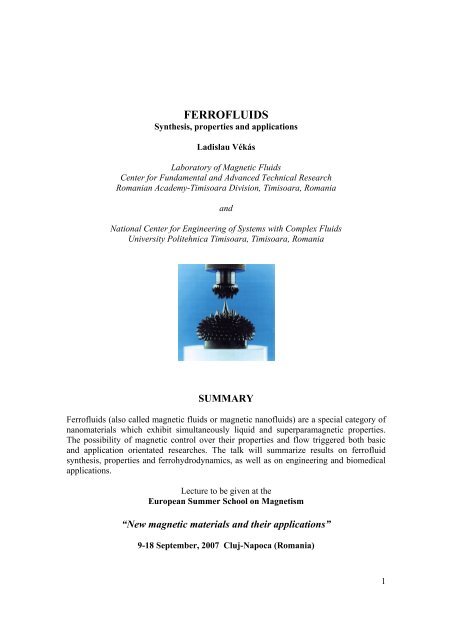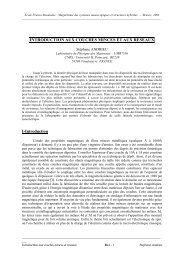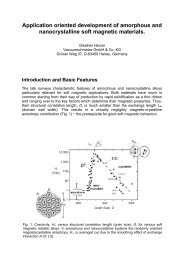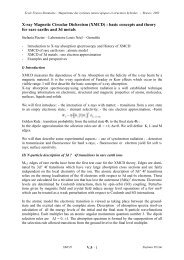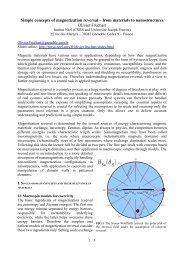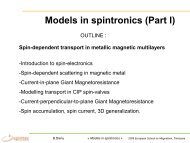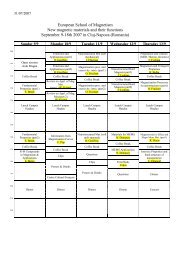FERROFLUIDS - The European School on Magnetism
FERROFLUIDS - The European School on Magnetism
FERROFLUIDS - The European School on Magnetism
You also want an ePaper? Increase the reach of your titles
YUMPU automatically turns print PDFs into web optimized ePapers that Google loves.
<str<strong>on</strong>g>FERROFLUIDS</str<strong>on</strong>g><br />
Synthesis, properties and applicati<strong>on</strong>s<br />
Ladislau Vékás<br />
Laboratory of Magnetic Fluids<br />
Center for Fundamental and Advanced Technical Research<br />
Romanian Academy-Timisoara Divisi<strong>on</strong>, Timisoara, Romania<br />
and<br />
Nati<strong>on</strong>al Center for Engineering of Systems with Complex Fluids<br />
University Politehnica Timisoara, Timisoara, Romania<br />
SUMMARY<br />
Ferrofluids (also called magnetic fluids or magnetic nanofluids) are a special category of<br />
nanomaterials which exhibit simultaneously liquid and superparamagnetic properties.<br />
<str<strong>on</strong>g>The</str<strong>on</strong>g> possibility of magnetic c<strong>on</strong>trol over their properties and flow triggered both basic<br />
and applicati<strong>on</strong> orientated researches. <str<strong>on</strong>g>The</str<strong>on</strong>g> talk will summarize results <strong>on</strong> ferrofluid<br />
synthesis, properties and ferrohydrodynamics, as well as <strong>on</strong> engineering and biomedical<br />
applicati<strong>on</strong>s.<br />
Lecture to be given at the<br />
<str<strong>on</strong>g>European</str<strong>on</strong>g> Summer <str<strong>on</strong>g>School</str<strong>on</strong>g> <strong>on</strong> <strong>Magnetism</strong><br />
“New magnetic materials and their applicati<strong>on</strong>s”<br />
9-18 September, 2007 Cluj-Napoca (Romania)<br />
1
1. INTRODUCTION<br />
Ferrofluids (known also as magnetic fluids) are a special category of smart nanomaterials,<br />
in particular magnetically c<strong>on</strong>trollable nanofluids [1]. <str<strong>on</strong>g>The</str<strong>on</strong>g>se types of nanofluids are<br />
colloids of magnetic nanoparticles, such as Fe 3 O 4 , γ-Fe 2 O 3 , CoFe 2 O 4 , Co, Fe or Fe-C,<br />
stably dispersed in a carrier liquid [2]. C<strong>on</strong>sequently, these nanomaterials manifest<br />
simultaneously fluid and magnetic properties. Macroscopically, the introducti<strong>on</strong> of<br />
magnetic forces into the fundamental hydrodynamic equati<strong>on</strong>s for the quasihomogeneous<br />
magnetizable liquid medium gives rise to the magnetohydrodynamics of magnetic<br />
nanofluids (ferrofluids), known also as ferrohydrodynamics and opens up an entire field<br />
of new phenomena [3] and promising applicati<strong>on</strong>s [4]. From a microscopic point of view,<br />
l<strong>on</strong>g-range, attractive van der Waals and magnetic forces are ubiquitous and therefore<br />
must be balanced by Coulombic, steric or other interacti<strong>on</strong>s to c<strong>on</strong>trol the colloidal<br />
stability of dispersed nanoparticle system, even in intense and str<strong>on</strong>gly n<strong>on</strong>-uniform<br />
magnetic field, specific to most of the applicati<strong>on</strong>s [5, 6].<br />
Many of the envisaged applicati<strong>on</strong>s, e.g., rotating seals or bearings, require magnetic<br />
fluids with high magnetizati<strong>on</strong> and at the same time, with l<strong>on</strong>g-term colloidal stability.<br />
<str<strong>on</strong>g>The</str<strong>on</strong>g>se requirements are difficult to fulfill simultaneously and implies severe c<strong>on</strong>diti<strong>on</strong>s<br />
<strong>on</strong> the stabilizati<strong>on</strong> procedures applied during the synthesis of magnetic nanofluids.<br />
<str<strong>on</strong>g>The</str<strong>on</strong>g> compositi<strong>on</strong>, structure and properties of various types of ferrofluids will be presented,<br />
refering also to technological and biomedical applicati<strong>on</strong>s envisaged for these nanofluids<br />
[2, 5].<br />
2. SYNTHESIS OF <str<strong>on</strong>g>FERROFLUIDS</str<strong>on</strong>g><br />
<str<strong>on</strong>g>The</str<strong>on</strong>g> synthesis of ferrofluids has two main steps: (a) the preparati<strong>on</strong> of nano-sized<br />
magnetic particles (2-15 nm) and (b) the subsequent dispersi<strong>on</strong>/stabilizati<strong>on</strong> of the<br />
nanoparticles in various n<strong>on</strong>-polar and polar carrier liquids. In what c<strong>on</strong>cerns the ferrite<br />
nanoparticles, the most efficient route is the chemical co-precipitati<strong>on</strong> process [2].<br />
Depending <strong>on</strong> the carrier properties and applicati<strong>on</strong>s envisaged, different procedures of<br />
ferrofluid synthesis were developed, which will be shortly reviewed [5]. <str<strong>on</strong>g>The</str<strong>on</strong>g> stabilizati<strong>on</strong><br />
mechanisms of magnetic nanoparticles in various kind of carrier liquids, which should<br />
prevent irreversible particle agglomerate formati<strong>on</strong> even in intense and str<strong>on</strong>gly n<strong>on</strong>uniform<br />
magnetic field, will be discussed.<br />
3. CHARACTERIZATION<br />
3.1. Structural investigati<strong>on</strong>s and colloidal stability In the case of sterically stabilized<br />
nanoparticles in various carrier liquids, the type and quality of surfactants used, as well as<br />
the temperature of the medium will determine the efficiency of particle surface covering<br />
and, c<strong>on</strong>sequently, the balance between attractive and repulsive interacti<strong>on</strong>s between<br />
particles. <str<strong>on</strong>g>The</str<strong>on</strong>g> attractive interacti<strong>on</strong>s, when prep<strong>on</strong>derant, may lead to various types of<br />
agglomerates, usually in the shape of linear chains quasi-parallel to the applied magnetic<br />
field or drop-like aggregates [7]. <str<strong>on</strong>g>The</str<strong>on</strong>g> agglomerati<strong>on</strong> processes are not desired in the case<br />
of magnetic fluids used in most of the applicati<strong>on</strong>s; therefore the characterizati<strong>on</strong><br />
methods are mainly focused <strong>on</strong> these processes and <strong>on</strong> their c<strong>on</strong>sequences in the<br />
macroscopic behaviour of the fluids.<br />
One of the most efficient methods of nanostructural investigati<strong>on</strong> is based <strong>on</strong> small angle<br />
neutr<strong>on</strong> scattering (SANS) [8]. This method is applied to reveal structural features at the<br />
2
scale of 1-100 nm and it will be presented in detail, beside results of TEM, DLS and<br />
magnetogranulometric analyses.<br />
3.2. Magnetic properties Magnetizati<strong>on</strong> curves can be extensively used for the study of<br />
both particle interacti<strong>on</strong>s and agglomerate formati<strong>on</strong>, processes which str<strong>on</strong>gly influence<br />
the rheological and magnetoheological behaviour of magnetic fluids. Saturati<strong>on</strong><br />
magnetizati<strong>on</strong> (M s ), initial susceptivity (χ i ), full magnetizati<strong>on</strong> curves (M=M(H) or<br />
M/M s (H), (H-intensity of applied magnetic field) and magneto-granulometric analysis<br />
(mean magnetic diameter and standard deviati<strong>on</strong> σ), at various values of the<br />
volumic c<strong>on</strong>centrati<strong>on</strong> of magnetic nanoparticles, give an insight <strong>on</strong> microstructural<br />
characteristics of various samples to be compared [9,10]. <str<strong>on</strong>g>The</str<strong>on</strong>g> dimensi<strong>on</strong> of the clusters<br />
can give a first hint about both the degree of particle dispersi<strong>on</strong> and the strength of the<br />
interparticle interacti<strong>on</strong>s. Usually, it can be analyzed via optical methods (e.g. DLS). In<br />
spite of the clustering process, the net attractive inter-particle interacti<strong>on</strong>s (c<strong>on</strong>sidered as<br />
dipole-dipole type) should be quite weak, due to the steric repulsi<strong>on</strong> induced by the<br />
double coating layers. <str<strong>on</strong>g>The</str<strong>on</strong>g> attractive interacti<strong>on</strong>s are c<strong>on</strong>sidered to induce <strong>on</strong>ly<br />
perturbati<strong>on</strong>s of the main anisotropy energy of the particles. Temperature dependent<br />
Mössbauer spectroscopy [11] is providing informati<strong>on</strong> <strong>on</strong> particle phase compositi<strong>on</strong>,<br />
local structure and symmetry, local magnetic interacti<strong>on</strong>s inside the particle and Néeltype<br />
relaxati<strong>on</strong> phenomena.<br />
3.3 Rheological and magnetorheological properties [12] depend especially <strong>on</strong><br />
compositi<strong>on</strong>, particle volume fracti<strong>on</strong> and degree of colloidal stability of ferrofluids, as<br />
well as <strong>on</strong> the intensity of applied magnetic field. Methodology of investigati<strong>on</strong>s <strong>on</strong> flow<br />
properties and main results will be reviewed, with str<strong>on</strong>g emphasis <strong>on</strong> specially tailored<br />
ferrofluids for applicati<strong>on</strong>s.<br />
4. FERROHYDRODYNAMICS<br />
Equati<strong>on</strong>s of ferrohydrodynamics, developed initially by Neuringer and Rosensweig [3],<br />
will be synthesized. First, the equati<strong>on</strong>s resulting for a quasihomogeneous ferrofluid in<br />
the quasistatic approximati<strong>on</strong> will be presented, which corresp<strong>on</strong>d to a diluted ferrofluid,<br />
with pointlike magnetic dipoles and ideal Langevin behavior of magnetizati<strong>on</strong> in a slowly<br />
varying field. Next, the model of ferrofluids with internal rotati<strong>on</strong>s (Shliomis [13],<br />
Rosensweig [14]) taking into account the relaxati<strong>on</strong> of magnetizati<strong>on</strong> by Néel or Brown<br />
type mechanism, will be shortly outlined.<br />
5. TECHNOLOGICAL and BIOMEDICAL APPLICATIONS [1-6, 15-17]<br />
Synthesis of new type of hybrid nanostructured materials: polymeric nanocomposites,<br />
magnetically c<strong>on</strong>trolled gels and emulsi<strong>on</strong>s; Dynamic sealing with magnetic fluids;<br />
Magnetic fluid bearings; Moving coil speakers with magnetic fluid damping and cooling;<br />
Inertia dampers with magnetic fluids; Sensors and actuators; Magnetohydrostatic<br />
separati<strong>on</strong>; Surface finshing techniques; N<strong>on</strong>-destructive testing; Domain pattern<br />
investigati<strong>on</strong>s; Multifuncti<strong>on</strong>al magnetic particles, magnetic nanobeads; Magnetic cell<br />
separati<strong>on</strong>; Magnetic c<strong>on</strong>trast agents, MRI; Hyperthermia of tumors; Magnetic drug<br />
delivery.<br />
REFERENCES<br />
1. S. ODENBACH (Editor), Ferrofluids: Magnetically c<strong>on</strong>trollable fluids and their applicati<strong>on</strong>s, Lecture<br />
Notes in Physics, Springer-Verlag, 253 pags (2002).<br />
3
2. S. W. CHARLES, <str<strong>on</strong>g>The</str<strong>on</strong>g> preparati<strong>on</strong> of magnetic fluids, in: S. ODENBACH (Editor), Ferrofluids:<br />
Magnetically c<strong>on</strong>trollable fluids and their applicati<strong>on</strong>s, Lecture Notes in Physics, Springer-Verlag, pp.3-18,<br />
2002. See also: S. W. CHARLES, Preparati<strong>on</strong> and magnetic properties of magnetic fluids, Rom. Repts. Phys.,<br />
vol.47 (3-5), pp.249-264, 1995.<br />
3. R.E. ROSENSWEIG, Ferrohydrodynamics, Cambridge Univ. Press, pp.344, 1985; see also J.L. Neuringer,<br />
R.E. Rosensweig, Phys. Fluids 7(1964)1927<br />
4. B. BERKOVSKY, V. BASHTOVOI (Eds.), Magnetic fluids and applicati<strong>on</strong>s handbook, Begell House, New<br />
York, pp.831, 1996.<br />
5. L. VEKAS, D. BICA, M. V. AVDEEV, Magnetic nanoparticles and c<strong>on</strong>centrated magnetic nanofluids:<br />
synthesis, properties and some applicati<strong>on</strong>s, China Particuology, 2007 (to appear); see also: I. ANTON, I.<br />
DE SABATA, L. VEKAS, Applicati<strong>on</strong> orientated researches <strong>on</strong> magnetic fluids, J. Magn. Magn. Mater.,<br />
vol.85, pp.219-226, 1990.<br />
6. K. RAJ, Magnetic fluids and devices: a commercial survey, in: B. BERKOVSKY, V. BASHTOVOI (Eds.),<br />
Magnetic fluids and applicati<strong>on</strong>s handbook, Begell House, New York, pp.657-751 (1996)<br />
7. V. CABUIL, J.C. BACRI, R. PERZYNSKY, YU. RAIKHER, Colloidal stability of magnetic fluids, in: B.<br />
BERKOVSKY, V. BASHTOVOI (Eds.), Magnetic fluids and applicati<strong>on</strong>s handbook, Begell House, New York,<br />
pp.33-56 (1996).<br />
8. M.V. Avdeev, V.L. Aksenov, M. Balasoiu, V.M. Garamus, A. Schreyer, Gy. Torok, L. Rosta, D. Bica,.<br />
L. Vekas, Comparative analysis of the structure of sterically stabilized ferrofluids <strong>on</strong> polar carriers by<br />
small-angle neutr<strong>on</strong> scattering, J. Coll.Interface Sci., 295(2006)100-107; see also: M.V. Avdeev, C<strong>on</strong>trast<br />
variati<strong>on</strong> in small-angle scattering experiments <strong>on</strong> polydisperse and superparamagnetic systems: basic<br />
functi<strong>on</strong> approach, J. Appl.Cryst., 40(2007)56-70.<br />
9. M. RASA, D. BICA, A.P. PHILIPSE, L. VEKAS, Diluti<strong>on</strong> series approach for investigati<strong>on</strong> of microstructural<br />
properties and particle interacti<strong>on</strong>s in high-quality magnetic fluids, Eur. Phys. J. E (2002), vol.7, pp.209-<br />
220.<br />
10. A. O. Ivanov, O. B. Kuznetsova, Interparticle correlati<strong>on</strong>s and magnetic properties of c<strong>on</strong>centrated<br />
ferrocolloids, Collod J., vol.63, pp.60-67, 2001.<br />
11. V. Kuncser, G. Schinteie, B. Sahoo, W. Keune, D. Bica, L. Vékás, G. Filoti, Magnetic interacti<strong>on</strong>s in<br />
water-based ferrofluids studied by Mössbauer spectroscopy. J. Phys.: C<strong>on</strong>d. Matter. (2007)19(1)016205-<br />
016221<br />
12. S. Odenbach, Magnetoviscous effects in ferrofluids, Springer LNP m71 (Berlin, New York, 2002)<br />
13. M.I. Shliomis, Ferrohydrodynamics: Retrospective and Issues, in: S. ODENBACH (Editor), Ferrofluids:<br />
Magnetically c<strong>on</strong>trollable fluids and their applicati<strong>on</strong>s, Lecture Notes in Physics, Springer-Verlag, pp.85-<br />
110, 2002.<br />
14. R. E. Rosensweig, Basic Equati<strong>on</strong>s for Magnetic Fluids with Internal Rotati<strong>on</strong>s, in: S. ODENBACH<br />
(Editor), Ferrofluids: Magnetically c<strong>on</strong>trollable fluids and their applicati<strong>on</strong>s, Lecture Notes in Physics,<br />
Springer-Verlag, pp.61-84, 2002.<br />
15. Turcu R., Pana O., Nan A. and Giurgiu L. M. Polymeric Nanostructures and <str<strong>on</strong>g>The</str<strong>on</strong>g>ir Applicati<strong>on</strong>s vol 1,<br />
ed. H.S. Nalwa (American Scientific Publishers) pp 337-99(2007); see also Eunate Goiti, Rebeca<br />
Hernández, , Ruy Sanz, Daniel López, Manuel Vázquez, Carmen Mijangos, Rodica Turcu, Alexandrina<br />
Nan, Doina Bica, Ladislau Vekas, Novel nanostructured magneto-polymer composites, Journal of<br />
Nanostructured Polymers and Nanocomposites 2(2006)5-12 .<br />
16. Z. Varga, J. Feher, G. Filipcsei, M. Zrinyi, Smart nanocomposite polymer gels, Macromolecular<br />
Symposia, 200 (2003)93-100.] Z. Varga, G. Filipcsei, M. Zrinyi, Smart composites with c<strong>on</strong>trolled<br />
anisotropy, Polymer, 46(2005)7779-7787.<br />
17. Neuberger, T., Schopf, B., Hofmann, H., Hofmann, M. & Rechenberg, B. Superparamagnetic<br />
nanoparticles for biomedical applicati<strong>on</strong>s: Possibilities and limitati<strong>on</strong>s of a new drug delivery system. J.<br />
Magn. Magn. Mater., 293(2005) 483-496.<br />
18. Pankhurst, Q.A., C<strong>on</strong>nolly, J., J<strong>on</strong>es, S.K. & Dobs<strong>on</strong> J. , Applicati<strong>on</strong>s of magnetic nanoparticles in<br />
biomedicine. J. Phys. D: Appl.Phys., 36(2003) R167-R181.<br />
4


